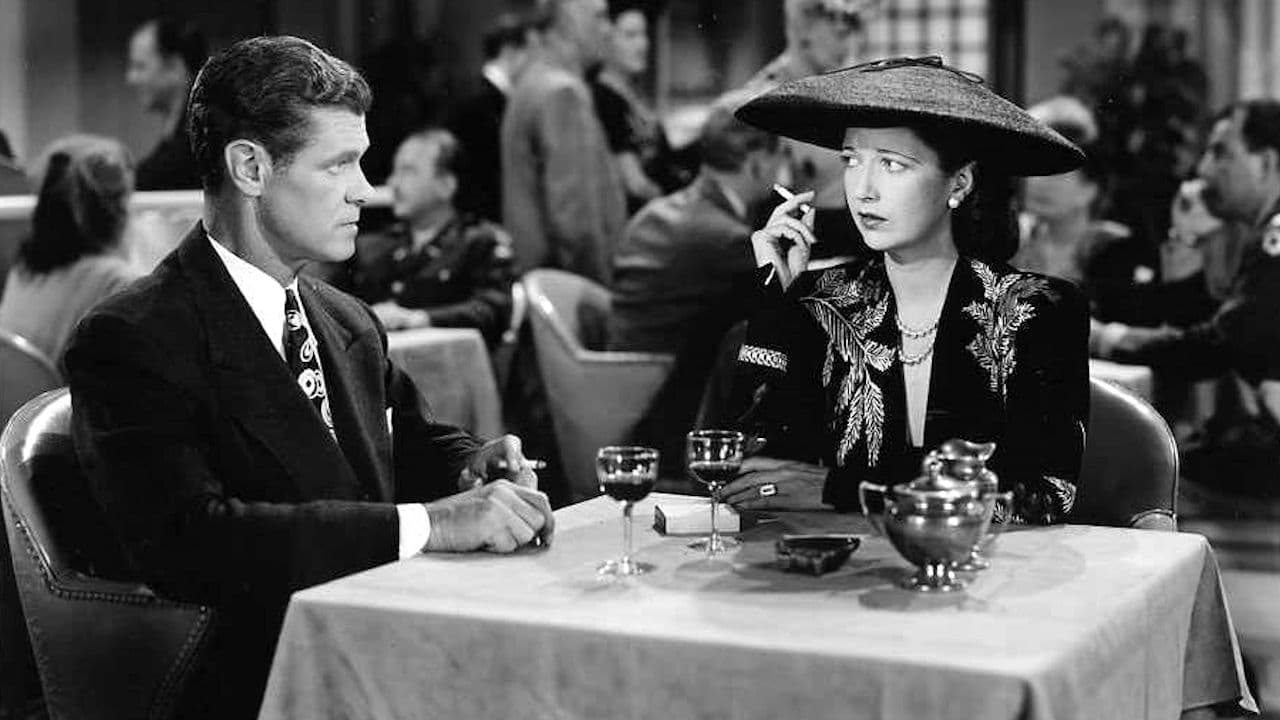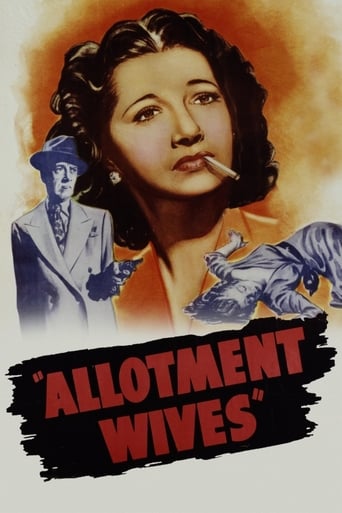



I like the storyline of this show,it attract me so much
View MoreVery very predictable, including the post credit scene !!!
View MoreA bit overrated, but still an amazing film
Not sure how, but this is easily one of the best movies all summer. Multiple levels of funny, never takes itself seriously, super colorful, and creative.
View More"Allotment Wives" is a 1945 film from a poverty row studio, Monogram. And it looks like that's where it came from: a bad print that kept freezing and rotten sound.But give Kay Francis credit. Even when she knew Warner Brothers was trying to get rid of her, she kept right on working as if the rotten parts didn't bother her at all. By 1945, Francis was all but through, and she starred in this film. It's the story of a ring of women who married several servicemen at a time in order to get their pay as well as their life insurance if they were killed. The leader of the group runs a tight ship, but trouble begins when a government agent posing as a reporter starts snooping around.I wasn't as impressed with this film as several others on this board. I thought it was routine. I always enjoy Kay Francis, very much a star in the early '30s. Here she's in a Joan Crawford type of role and handles it differently from the way Joan would have, much more subtly. Paul Kelly and Otto Kruger are featured and give good performances.Kay Francis returned to her stage roots in the '40s and finally retired in 1952. When she died, she left one million dollars to train Seeing Eye Dogs.There's an interesting story about her. Once when she had been retired for some time, she was recognized. "Aren't you Kay Francis?" someone asked. She answered, "I was."
View MoreTough, Hard-Boiled "Social" Crime Drama from Low-Rent Monogram Pictures. This is one of Their Betters. Starring on the Skids, but not quite on Skid-Row, Kay Francis and the Always Reliable Paul Kelly with some, had been a Star, but not quite a Has-Been Support, from Otto Kruger as what else, a Snakey, but in the End more than just a Bad Guy.It has its Moments of Violence, Melodrama, and Social Commentary and is a Rather Engaging piece of Noirish Business. That of Unscrupulous Women Marrying Military Types by the Handful for not Love but Money. The Head of this 'Syndicate" is a Woman Herself (Miss Francis) who has a Daughter that Figures in quite Heavily in this Heavy Handedness.There are some Memorable Scenes in Bedrooms, Staircases, and Prison Cells that would seem to Fit Easily into Film-Noir, but its Flat and Less than Creative Style, mostly Overlit and Pedestrian, that keeps this one Barely Eligible, but does manage in the End to have Enough of what it Takes to be a Contender.
View MoreIn 1945, with offers dwindling, Kay Francis made a last attempt at a film comeback by forming her own producing company with Jeffrey Bernerd. Bernerd was a feisty Englishman who had produced some exploitation movies, including "Where Are Your Children" and "Are These Our Parents". Even though Kay had been associated with studios such as Paramount and Warner Bros., the studio where Kay ended up making her last three movies was lowly Monogram, "the graveyard of burned out stars". Though Bernerd remembered her royal treatment in her heyday he was surprised at her ruthless penny pinching approach which included looking out for low budget stories and with "Allotment Wives" even rewriting the script. The picture had a 10 day shooting schedule with the main objective being to make money. Kay certainly did try to tackle hard hitting subjects, first with "Divorce" and now with "Allotment Wives" which tried to delve into the problem of women who bigamously marry soldiers in order to collect benefits.This movie, which allowed Kay to be totally unsympathetic yet fascinating, starts in an almost documentary fashion, introducing the "Office of Dependency Benefits" which supported the wives of servicemen. When Peter Martin (Paul Kelly) finds that his good friend has killed himself (due to finding out his new bride already has several husbands) he goes under cover and his search leads him to Sheila Seymour (Francis). She runs a canteen that caters for servicemen in more ways than the obvious. She recruits her "hostesses" from her beauty shop which in turn is a front for a "Allotment Wives" syndicate.One of the hostesses, Gladys Smith (Gertrude Michael) recognises Sheila as an old partner in crime. They had both been petty criminals although Sheila mysteriously escaped reform school and now Gladys is out for revenge and she finds it in Connie. Connie (Teala Loring) is Sheila's secret, a rebellious daughter who she has been shielding in an exclusive girl's school but Connie is only too eager to get involved in the high living and bright lights that Gladys introduces her to. Toward the end the movie swings into action with Sheila showing to what lengths she will go to, to protect her daughter. Guns blaze, bodies fall over beds, even Sheila's right hand man, Whitey (Otto Kruger) takes a bullet to protect Connie who doesn't seem a particularly agreeable girl.Gertrude Michael turned up in many programmers during the thirties, always playing elegant types, so she must have hoped a surprising lead in "The Notorious Sophie Lang" (1934) would push her into the big time. Unfortunately she was disappointed and by the early 1940s she was even clinging on to poverty row programmers but she could always be proud of Sophie Lang.
View MoreAllotment Wives (1945)You might moan when you hear the official voice-over talking about the War Department's benefits program and such. But hang in there. The intro is brief, and it's kind interesting, and it sets up the main movie, which has a great hook: women marrying several absentee G.I. men at once so they can collect multiple benefits. Including big death benefits if the men never returned..This isn't a brilliant affair, but it's better than you'd expect. It has some mediocre acting and routine filming, but it also some some really good parts. The key is the story, and the way the investigator (one main man, a curious, underplayed part by an underused, quirky actor, Paul Kelly) does his job.The leading female is played by Kay Francis. Never heard of her? She was Warner Bros. number one actress for several years in the early 1930s. Yes, and yet has really no single film to point to that has held up as great (she did do an interesting George Cukor movie early in both of their careers). But she's terrific with this middling material, and feels like an undiscovered leading lady. There's a scene between her and her saucy daughter that ends in a slap that will remind you of a similar scene in "Mildred Pierce" a year later. But Francis is usually just likable, even as she runs a lucrative scheme right in front of the U.S. Gov't's nose.There are straight, great noir films with lesser plots, to tell the truth, but this one is filmed in a bright, flat way, with the camera often just sitting there as the actors go through their lines in the lights. Not that you need shadowy drama all the time, but drama, and a physical presence, and a higher sense of style and art. Director William Nigh has a whole slew of these B-movies to his name, and he is often too functional for his own good.
View More